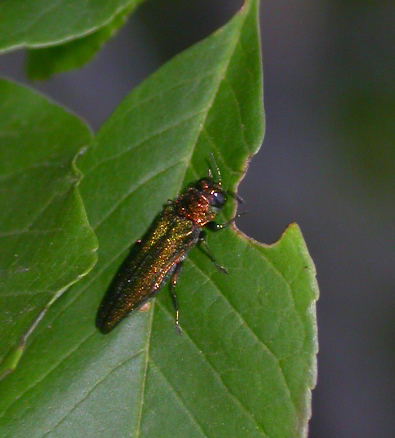Cliff Sadof, Purdue researchers release natural enemy of emerald ash borer
 |
Emerald ash borer feeding on a leaf. |
Noblesville Daily Times
Press Release
June 18, 2008
WEST LAFAYETTE, Ind. - Three species of wasps collected from ash trees in China have the potential to save ash trees in North America.
On Thursday (June 19) Purdue University researchers, armed with permits from the Indiana Department of Natural Resources and the U.S. Department of Agriculture Animal Plant Health Inspection Service, will begin to release 200 of the first wasp species in an ash forest near Rousch Lake in Huntington.
These wasps lay their eggs into the eggs of emerald ash borers (EAB). As the wasps feed, grow and develop, they eventually kill the ash borer eggs.
"In China, these wasp species reduced EAB populations by 74 percent in ash trees that are native to North America," said Cliff Sadof, Purdue professor of entomology. "With more than 8 billion ash trees at risk, these wasps offer real hope for reducing the possibility of North American ash extinction."
Later in the summer two additional wasp species will be released in the same location. Both species feed on emerald ash borer larvae.
"Our study will determine whether the wasps are able to establish a population, overwinter and effectively control emerald ash borer in the state," Sadof said.
Michigan State University began the same study a year ago, and Ohio State University will begin its study this summer.
Beyond emerald ash borer, the wasps are known only to rarely attack related wood borers, but have been shown not to be harmful to humans or the environment.
"These small wasps have no stingers and are not aggressive toward humans," Sadof said. "In addition, laboratory studies show that they do not like to lay eggs inside the eggs of anything other than emerald ash borers. When given a choice, they avoid attacking all but the most closely related borer species that are known pests of oak and birch trees."
In the past, researchers have found success in fighting other invasive species with natural enemies.
"Overall, about one-third of the biological control efforts for invasive species have resulted in complete or substantial control of the target," said Steve Yaninek, head of Purdue's entomology department. "The other two-thirds had partial control, no measurable effects or the natural enemies never became established. Negative environmental effects have been rare."
But while researchers are optimistic about the study, Sadof said any control benefits could be a few years away.
"It's important for people to recognize that despite new developments in chemical and biological control, we still have a long way to go to protect our ash trees," he said. "It may take several years to get the wasps established in Indiana and even longer for them to build up numbers where they can kill enough of the borers to make a difference in the forest.
"For these reasons, it is critical for people to refrain from moving firewood and other ash products outside of quarantined areas."
Quarantined areas and more information about emerald ash borer is available online at http://www.entm.purdue.edu/EAB.
Questions regarding the biological control of emerald ash borer study should be directed to Sadof at (765) 494-5983,
csadof@purdue.edu.
This e-mail address is being protected from spam bots, you need JavaScript enabled to view it
Collaborators on this project are Deborah McCullough, Michigan State University; Dan Herms, Ohio State University; Leah Bauer and Hou Ping Liu, U.S. Forest Service; and Tonghai Zhao, Chinese Academy of Forestry in Beijing.
|